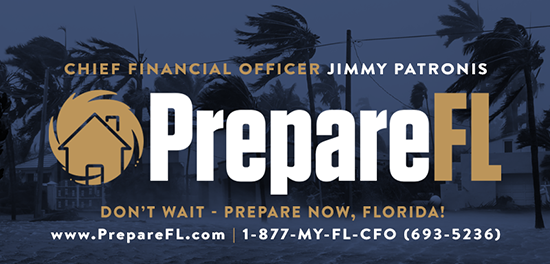Florida Chief Financial Officer (CFO) Jimmy Patronis has launched an initiative designed to encourage Floridians to prepare now before a hurricane makes landfall. According to a statement from the Florida Department of Financial Services, the new Prepare Florida initiative will focus on helping Floridians take steps to prepare their home and finances for a disaster.
“While Floridians know all too well the devastation hurricanes can have on their lives, it’s easy to not take the threat seriously,” Patronis said. “An active hurricane season is predicted, with the possibility of up to four major hurricanes. As we saw with Hurricane Michael, hurricanes can form and strengthen quickly, leaving little time to prepare and evacuate.”
The PrepareFL.com website serves as a one-stop-shop for disaster preparedness information and resources to help Floridians ensure they are prepared to weather the next storm, including:
- An Emergency Preparedness Toolkit designed to help residents prepare a home inventory and organize financial information before and after a disaster
- A Natural Disasters – Are You Prepared guide to inform consumers on insurance and financial preparation in the event of a natural disaster
- A guide to navigating the flood insurance claims process
- Information on the Assignment of Benefits (AOB) process and how it can impact a homeowner
- Tips on what to expect after filing a homeowners insurance claim related to a hurricane
The National Oceanic and Atmospheric Administration has predicted that as many as 8 hurricanes may form in the Atlantic in 2019, a “near normal” season following two years of storms that have left a trail of death and destruction in the Caribbean and U.S. coast.
Nine to 15 named storms are forecast during the six-month season that starts June 1, NOAA said, which has been largely correct with its predictions in recent years. Of those, 4 to 8 will become hurricanes and 2 to 4 will be major systems with winds of 111 miles (179 kilometers) per hour or more.
In 2018, storms Michael and Florence struck the U.S. South, causing widespread damage that’s still lingering as residents struggle to rebuild. Florence ripped into North Carolina in September, bringing record storm surge and rain that flooded homes and businesses before causing additional destruction across South Carolina. It’s blamed for 52 deaths, according to the National Hurricane Center.
The following month, Hurricane Michael leveled homes in Florida’s panhandle when it came ashore near Mexico Beach. The storm killed at least 16 and caused $25 billion in damage, the National Hurricane Center said. It was the third most intense storm in terms of central pressure and brought the fourth strongest winds of any to hit the contiguous U.S. on record.
“The time is now to prepare and protect your home and business,” Patronis said.
Was this article valuable?
Here are more articles you may enjoy.



 Louvre Tightens Security After $102M Jewel Heist, Installs Bars on Infamous Window
Louvre Tightens Security After $102M Jewel Heist, Installs Bars on Infamous Window  Head of EEOC Urges White Men to Report Discrimination
Head of EEOC Urges White Men to Report Discrimination  Underwriter, Actuary Fears of AI Drop; Work Needed on Collaboration
Underwriter, Actuary Fears of AI Drop; Work Needed on Collaboration  UPS Ripped Off Seasonal Workers With Unfair Pay Practices, Lawsuit Alleges
UPS Ripped Off Seasonal Workers With Unfair Pay Practices, Lawsuit Alleges 

